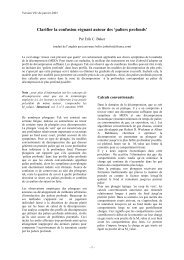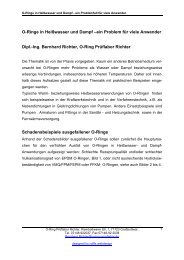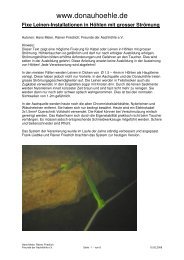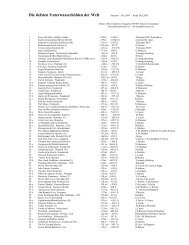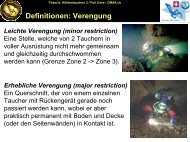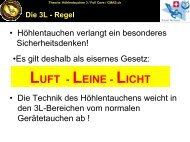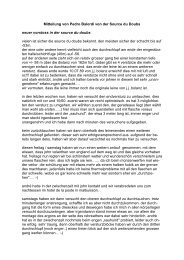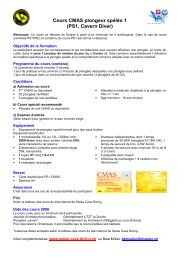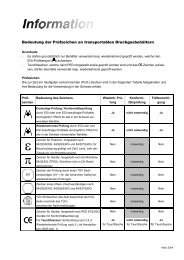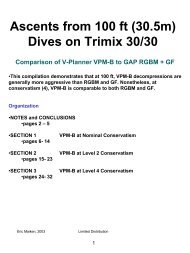cave diving and the nss - bei Swiss-Cave-Diving
cave diving and the nss - bei Swiss-Cave-Diving
cave diving and the nss - bei Swiss-Cave-Diving
Create successful ePaper yourself
Turn your PDF publications into a flip-book with our unique Google optimized e-Paper software.
50 CAVE DIVING COMMUNICATIONS<br />
reel so that, when pulled tight, <strong>the</strong>re is a direct line-to-line connection.<br />
<strong>Cave</strong> divers prefer to begin <strong>the</strong> tie-in a few inches away from<br />
<strong>the</strong> final tie-off of <strong>the</strong> permanent guideline. This is <strong>the</strong> same<br />
reasoning used in tying in <strong>the</strong> primary reel. Simply stated, it just<br />
avoids potential confusion from a mass of guideline <strong>and</strong> some work<br />
in recovering <strong>the</strong> temporary line. Some teams also prefer to add<br />
a clo<strong>the</strong>spin to <strong>the</strong> outbound side of <strong>the</strong> tie-in point. While this is<br />
not a universal practice, <strong>the</strong> addition of a clip does provide confirmation<br />
of <strong>the</strong> original exit direction.<br />
When tying onto <strong>the</strong> new permanent line, wrap <strong>the</strong> gap reel<br />
around <strong>the</strong> new line twice <strong>and</strong> clip <strong>the</strong> gap reel onto <strong>the</strong> new line<br />
in <strong>the</strong> direction in which <strong>the</strong> team is traveling. This makes retrieval<br />
of <strong>the</strong> gap reel easier <strong>and</strong> serves as notice to o<strong>the</strong>r teams that your<br />
team is not only using a particular line, but traveling on that line in<br />
a particular direction.<br />
REELS AND LINE MARKERS 51<br />
JUMP REELS<br />
A jump reel is used to connect <strong>the</strong> middle of one permanent<br />
line to <strong>the</strong> end or middle of ano<strong>the</strong>r line. Jump reels <strong>and</strong> gap reels<br />
may be exactly <strong>the</strong> same type of reel, differing only in application.<br />
If you are going to be leaving or entering <strong>the</strong> middle of ano<strong>the</strong>r line,<br />
<strong>the</strong>n directional decisions are going to be encountered during <strong>the</strong><br />
exit. Minimize <strong>the</strong>se decisions during <strong>the</strong> entry; don't rely on visual<br />
indicators alone. At <strong>the</strong> very least, a team will install a clip to <strong>the</strong><br />
outbound side of <strong>the</strong> jump-off point. This task is typically assigned<br />
to <strong>the</strong> second man. O<strong>the</strong>rs prefer to install an arrow for additional<br />
directional confidence. Still o<strong>the</strong>rs prefer <strong>the</strong> security of using both<br />
an arrow <strong>and</strong> a clip, while still o<strong>the</strong>rs prefer that each member of<br />
<strong>the</strong> team mark <strong>the</strong> jump-off point using ei<strong>the</strong>r an arrow or a clip.<br />
The GAP REEL versus <strong>the</strong> JUMP REEL<br />
Gap reels <strong>and</strong> jump reels are typically interchangeable, <strong>bei</strong>ng<br />
differentiated primarily by function ra<strong>the</strong>r than appearance or<br />
design. Both are typically smaller physically than <strong>the</strong> primary<br />
reel <strong>and</strong> are usually designed to hold only about 50 feet of line.<br />
A "gap" is defined as <strong>the</strong> distance spanned by a temporary reel<br />
between <strong>the</strong> end of one permanently installed guideline <strong>and</strong> <strong>the</strong><br />
beginning of ano<strong>the</strong>r. Thus with gap reels <strong>the</strong>re are no directional<br />
decisions to be made. A "jump," by contrast, involves spanning<br />
<strong>the</strong> distance between <strong>the</strong> middle of one line <strong>and</strong> <strong>the</strong> beginning or<br />
middle of ano<strong>the</strong>r line, or vice versa. Thus, <strong>the</strong> use of jump<br />
reels will involve planning for one or more directional decisions.<br />
Installing a gap or jump reel<br />
Place <strong>the</strong> end loop of <strong>the</strong> reel line over <strong>the</strong> permanent line, <strong>the</strong>n<br />
feed <strong>the</strong> reel through this loop <strong>and</strong> pull tight. When properly<br />
joined to <strong>the</strong> beginning or middle of <strong>the</strong> o<strong>the</strong>r permanent line, a<br />
direct, line-to-line connection is <strong>the</strong> result. Some <strong>cave</strong> divers prefer<br />
to have a small brass or stainless-steel snap attached to <strong>the</strong> loop,<br />
but while this snap may be useful in maintaining control of <strong>the</strong> reel<br />
line, it should not be trusted to provide <strong>the</strong> line-to-line connection.




